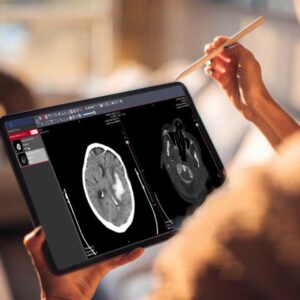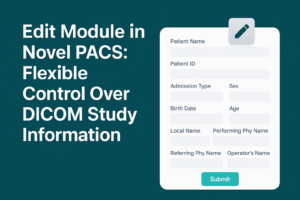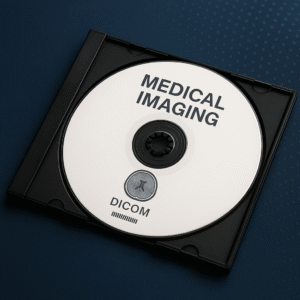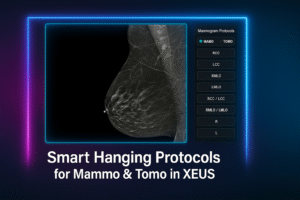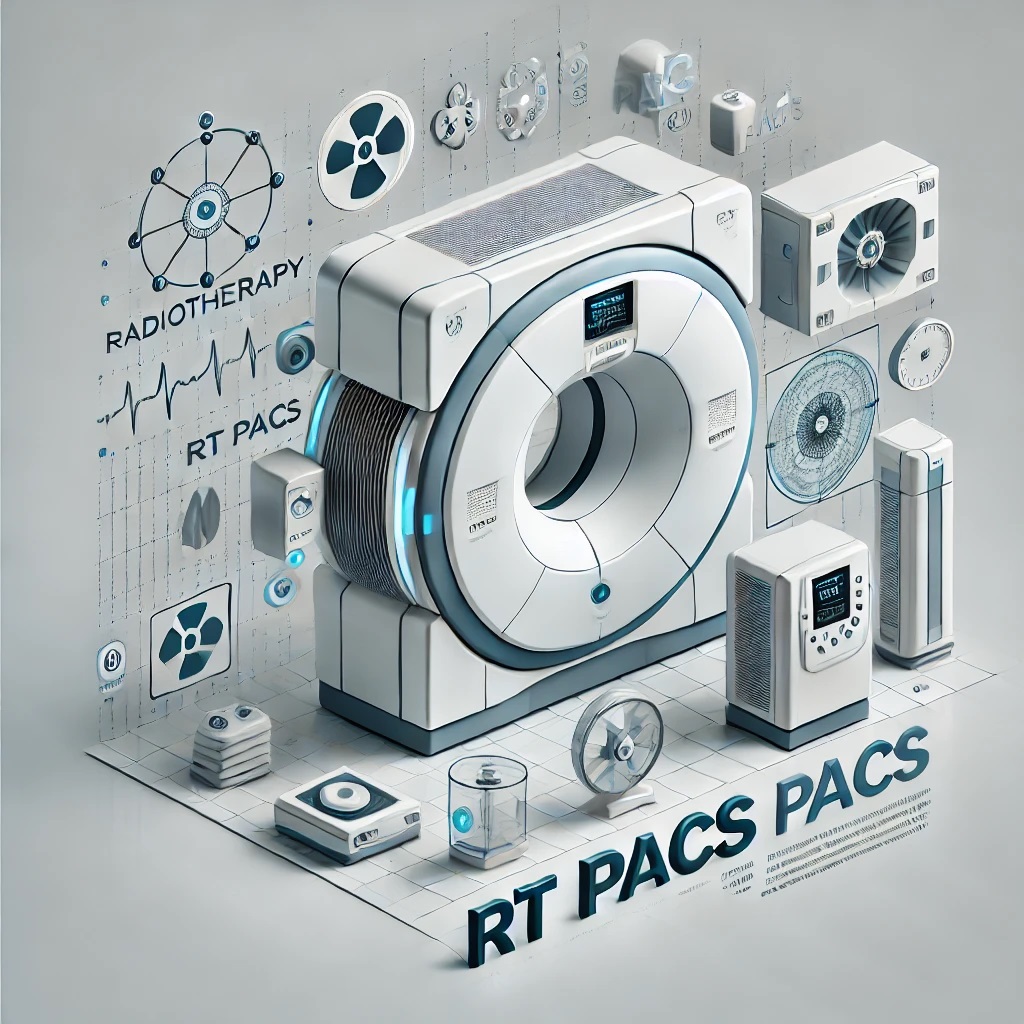Radiotherapy is a critical component of cancer treatment, leveraging high-energy radiation to target and destroy cancer cells. As with all modern medical treatments, radiotherapy relies heavily on advanced imaging technologies to ensure precision and effectiveness. This is where Radiotherapy PACS (RT PACS) comes into play. RT PACS systems are specialized Picture Archiving and Communication Systems designed to handle the unique imaging and data management needs of radiotherapy departments. In this blog post, we will explore what RT PACS is, how it works, and its crucial role in the diagnosis and treatment of cancer. We will also delve into the features of RT DICOM Viewers and highlight MiNNOVAA’s XEUS as a leading solution in this space.
What is RT PACS?
RT PACS, or Radiotherapy PACS, is a specialized type of PACS system tailored specifically for use in radiotherapy. Unlike general PACS systems that manage a broad range of medical imaging, RT PACS is designed to handle the specific requirements of radiotherapy planning, execution, and follow-up.
Key Characteristics of RT PACS:
- Integration with Radiotherapy Planning Systems: RT PACS seamlessly integrates with treatment planning systems (TPS) used in radiotherapy. This integration ensures that imaging data is accurately utilized in creating detailed treatment plans.
- Support for Multiple Modalities: RT PACS can manage and store images from various modalities, including CT, MRI, PET, and X-ray, which are commonly used in planning and monitoring radiotherapy treatments.
- Precision and Accuracy: RT PACS focuses on delivering high levels of precision in image management, ensuring that the exact location, size, and shape of tumors are accurately captured and used in treatment planning.
How Does RT PACS Work?
RT PACS operates by integrating various components of the radiotherapy workflow, from imaging to treatment planning, execution, and follow-up. Here’s a closer look at how RT PACS works:
-
Image Acquisition:
- The process begins with the acquisition of high-resolution images using modalities such as CT, MRI, or PET scans. These images are crucial for identifying the exact location and extent of the tumor.
- RT PACS stores these images and organizes them in a way that allows easy access and retrieval throughout the treatment process.
-
Treatment Planning:
- The stored images are then used in conjunction with treatment planning software. RT PACS integrates with these systems to ensure that all relevant imaging data is available for creating a precise treatment plan.
- Treatment planning involves determining the exact dose of radiation, the number of sessions, and the angles at which the radiation should be delivered to target the tumor while sparing healthy tissues.
-
Treatment Delivery:
- During the delivery of radiotherapy, RT PACS continues to play a crucial role by ensuring that the treatment plan is followed precisely. This includes verifying the patient’s position and ensuring that the radiation is delivered according to the plan.
- In some cases, real-time imaging may be used to adjust the treatment on the fly, and RT PACS facilitates the storage and retrieval of these images.
-
Follow-Up and Monitoring:
- After the completion of radiotherapy, follow-up imaging is often performed to assess the treatment’s effectiveness. RT PACS stores these follow-up images alongside the initial treatment images, allowing for a comprehensive view of the patient’s progress.
- This data is crucial for evaluating the success of the treatment and planning any additional interventions if necessary.
Understanding RT PACS
To fully understand the importance of RT PACS, it’s essential to recognize the unique challenges associated with radiotherapy. Radiotherapy requires a high degree of precision because the goal is to deliver the maximum dose of radiation to the tumor while minimizing exposure to surrounding healthy tissues. This precision is achieved through meticulous planning, which relies heavily on accurate imaging data.
RT PACS plays a central role in this process by ensuring that all imaging data is accurately stored, organized, and readily accessible throughout the treatment process. This not only improves the accuracy of treatment planning but also enhances the overall efficiency of the radiotherapy workflow.
Delving Deeper into RT PACS
Let’s delve deeper into some of the specific features and capabilities of RT PACS:
-
Image Fusion and Registration:
- One of the advanced features of RT PACS is image fusion, which allows for the combination of images from different modalities (e.g., CT and MRI) into a single dataset. This is particularly useful in radiotherapy, where different imaging modalities provide complementary information about the tumor and surrounding tissues.
- Image registration is another critical capability, aligning images taken at different times or from different angles to ensure consistency in treatment planning.
-
Dose Management:
- RT PACS includes sophisticated tools for managing and verifying the radiation dose delivered to the patient. This includes tracking the cumulative dose over multiple sessions and ensuring that it remains within safe limits.
- Dose verification is essential for patient safety and for achieving the desired therapeutic outcomes.
-
Adaptive Radiotherapy:
- In some cases, the treatment plan may need to be adjusted during the course of therapy due to changes in the patient’s anatomy or tumor size. RT PACS supports adaptive radiotherapy by allowing for the modification of the treatment plan based on new imaging data.
- This adaptability ensures that the treatment remains effective even as the patient’s condition changes.
-
Data Security and Compliance:
- Given the sensitive nature of patient data, RT PACS includes robust security features to protect patient information. This includes encryption, access controls, and compliance with regulations such as HIPAA.
- Data integrity is critical in radiotherapy, where even small errors in the treatment plan can have significant consequences.
Usage of RT PACS in Diagnosis and Treatment
RT PACS is primarily used in the diagnosis, planning, and treatment of cancer through radiotherapy. Here’s how it contributes to each stage of the process:
-
Diagnosis:
- High-resolution imaging stored in RT PACS is used to accurately diagnose the extent and location of the tumor. This data is critical for determining the appropriate course of treatment, including whether radiotherapy is suitable.
-
Treatment Planning:
- RT PACS integrates with treatment planning systems to create detailed, individualized plans that specify how the radiation will be delivered. The precision and accuracy of these plans are vital for effective treatment.
-
Treatment Delivery:
- During the treatment phase, RT PACS ensures that the plan is followed precisely, with real-time imaging used to verify the patient’s position and the accuracy of the radiation delivery.
-
Follow-Up:
- After treatment, RT PACS stores follow-up imaging, allowing healthcare providers to assess the effectiveness of the therapy and make any necessary adjustments for future treatments.
RT DICOM Viewer
The RT DICOM Viewer is an essential component of RT PACS, providing radiologists and oncologists with the tools they need to visualize, analyze, and manipulate the imaging data used in radiotherapy. Here are some of the key features of an RT DICOM Viewer:
- Advanced Visualization: The RT DICOM Viewer offers advanced visualization tools, including 3D rendering and multi-planar reconstruction (MPR), allowing clinicians to view the tumor and surrounding tissues from multiple angles.
- Hanging Protocols: These viewers support customizable hanging protocols tailored to the needs of radiotherapy, ensuring that images are displayed in the most useful configurations for treatment planning and analysis.
- Structured Reporting: RT DICOM Viewers often include tools for creating structured reports, which document the treatment plan, dose distribution, and any modifications made during the course of treatment.
- Integration with Treatment Planning: The RT DICOM Viewer integrates seamlessly with radiotherapy treatment planning systems, ensuring that all relevant imaging data is available for precise planning and execution.
MiNNOVAA’s RT PACS and XEUS RT DICOM Viewer
MiNNOVAA, a leading innovator in the PACS industry, offers a state-of-the-art RT PACS solution designed to meet the specific needs of radiotherapy departments. Their RT PACS integrates advanced imaging capabilities with robust treatment planning tools, ensuring that healthcare providers have everything they need to deliver precise and effective radiotherapy treatments.
At the heart of MiNNOVAA’s RT PACS is the XEUS RT DICOM Viewer. This powerful tool is designed to provide radiologists and oncologists with the advanced features they need to visualize and analyze complex imaging data. The XEUS RT DICOM Viewer includes:
- Hanging Protocols for Radiotherapy: Customizable layouts specifically designed for radiotherapy workflows.
- 3D Volume Rendering: Advanced 3D visualization capabilities that help clinicians plan and verify treatment with precision.
- Structured Reporting and Voice-to-Text Conversion: Intelligent reporting features that streamline the documentation process, including voice-to-text conversion for quick and accurate report generation.
- Integration with MiNNOVAA’s RT PACS: Seamless integration ensures that all imaging data and treatment plans are easily accessible and securely stored, enhancing the overall efficiency of the radiotherapy process.
Conclusion
RT PACS plays a vital role in the delivery of radiotherapy, providing the tools and infrastructure needed to ensure that treatment is precise, effective, and safe. From diagnosis through to follow-up, RT PACS systems like those offered by MiNNOVAA are essential for managing the complex workflows involved in radiotherapy.
MiNNOVAA’s XEUS RT DICOM Viewer, with its advanced features and seamless integration with RT PACS, stands out as a leading solution for healthcare providers looking to optimize their radiotherapy practices. As radiotherapy continues to evolve, the importance of specialized PACS systems like RT PACS will only grow, ensuring that patients receive the best possible care throughout their treatment journey.
